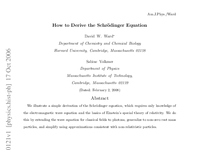Schrödinger's Equation
![[url=https://pixabay.com/en/dna-molecules-biology-module-1015661/]"DNA"[/url] by 3dman_eu is in the [url=http://creativecommons.org/publicdomain/zero/1.0/]Public Domain, CC0[/url]
DNA double helix. You may think of biology when you see the structure of DNA. It's structure can, at least in principle, be calculated from Schrödinger's equation.](https://www.geogebra.org/resource/Fu9Xxdqn/AnBCtDEXni84royA/material-Fu9Xxdqn.png)
Schrödinger Derivation Article
Schrödinger's Equation
Schrödinger's equation is the foundational equation of quantum mechanics in the same sense that Newton's 2nd law is foundational to classical mechanics. In general, books at this level make no efforts to derive it. In a sense you should not always expect expressions to be derivable in the first place since there must be some fundamental set of laws or axioms from which all other relations are derived. Schrödinger's equation is not fundamental at that level, and the paper above makes a good run at deriving it if you are interested in taking a look.
We are going to discuss the time-independent version of the equation as the time dependence would unnecessarily complicate our discussions. There is enough to learn without considering the time evolution of quantum systems, and fortunately for us, stable structures in nature like chemical bonds and atomic structure can be understood in the time-independent formalism. The linked paper above derives the time-dependent version.
Schrödinger's equation is often called Schrödinger's wave equation since the solutions tend to be waves. The equation was introduced to the world by Erwin Schrödinger in 1926 in the German research journal Annalen der Physik in a paper entitled (translated) "Quantization as an Eigenvalue Problem". If you have discussed eigenvectors and eigenvalues in math class, they are closely related to the mathematics of quantum physics. The wave function is really a linear set of eigenfunctions which solve Schrödinger's equation, and the corresponding eigenvalues are the energies of those states.
The mathematical form of Schrödinger's equation is:
I have written it without distributing the wave function since it is common to see the term in parentheses as an operator called the Hamiltonian, which is denoted . In shorthand the equation can then be rewritten . In this form which is reminiscent of matrix algebra (in case you are familiar with it), the wave function is the eigenfunction (or set of them) and energy is the corresponding eigenvalue (or set of values).
In Schrödinger's equation, the first term in the parentheses serves to find the kinetic energy of a system when acting on the wave function, and the second term U(x) is the potential energy. In this context the potential energy describes the environment. Instead of putting up walls and adding springs to problems like in mechanics studies, here we describe the interaction of the system with it's environment by describing a potential energy of interaction with the environment. Examples of this will follow shortly.
